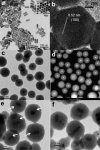Taking the temperature of the interiors of magnetically heated nanoparticles
- PMID: 24779552
- PMCID: PMC4046777
- DOI: 10.1021/nn501250e
Taking the temperature of the interiors of magnetically heated nanoparticles
Abstract
The temperature increase inside mesoporous silica nanoparticles induced by encapsulated smaller superparamagnetic nanocrystals in an oscillating magnetic field is measured using a crystalline optical nanothermometer. The detection mechanism is based on the temperature-dependent intensity ratio of two luminescence bands in the upconversion emission spectrum of NaYF4:Yb(3+), Er(3+). A facile stepwise phase transfer method is developed to construct a dual-core mesoporous silica nanoparticle that contains both a nanoheater and a nanothermometer in its interior. The magnetically induced heating inside the nanoparticles varies with different experimental conditions, including the magnetic field induction power, the exposure time to the magnetic field, and the magnetic nanocrystal size. The temperature increase of the immediate nanoenvironment around the magnetic nanocrystals is monitored continuously during the magnetic oscillating field exposure. The interior of the nanoparticles becomes much hotter than the macroscopic solution and cools to the temperature of the ambient fluid on a time scale of seconds after the magnetic field is turned off. This continuous absolute temperature detection method offers quantitative insight into the nanoenvironment around magnetic materials and opens a path for optimizing local temperature controls for physical and biomedical applications.
Figures





Similar articles
-
Size-dependent nonlinear weak-field magnetic behavior of maghemite nanoparticles.Small. 2012 Jun 25;8(12):1945-56. doi: 10.1002/smll.201102660. Epub 2012 Apr 10. Small. 2012. PMID: 22488765
-
Facile preparation of magnetic mesoporous MnFe2O4@SiO2-CTAB composites for Cr(VI) adsorption and reduction.Environ Pollut. 2017 Jan;220(Pt B):1376-1385. doi: 10.1016/j.envpol.2016.10.097. Epub 2016 Nov 9. Environ Pollut. 2017. PMID: 27836472
-
Shape and magnetic properties of single-crystalline hematite (alpha-Fe2O3) nanocrystals.Chemphyschem. 2006 Sep 11;7(9):1897-901. doi: 10.1002/cphc.200600130. Chemphyschem. 2006. PMID: 16881086 No abstract available.
-
One-pot two-step synthesis of core-shell mesoporous silica-coated gold nanoparticles.Dalton Trans. 2015 May 7;44(17):7752-6. doi: 10.1039/c5dt00912j. Dalton Trans. 2015. PMID: 25828393
-
Highly aqueous soluble CaF2:Ce/Tb nanocrystals: effect of surface functionalization on structural, optical band gap, and photoluminescence properties.J Mater Sci Mater Med. 2016 Dec;27(12):178. doi: 10.1007/s10856-016-5791-5. Epub 2016 Oct 17. J Mater Sci Mater Med. 2016. PMID: 27752975
Cited by
-
Active Thermal Extraction and Temperature Sensing of Near-field Thermal Radiation.Sci Rep. 2016 Sep 6;6:32744. doi: 10.1038/srep32744. Sci Rep. 2016. PMID: 27595609 Free PMC article.
-
Photothermia at the nanoscale induces ferroptosis via nanoparticle degradation.Nat Commun. 2023 Aug 2;14(1):4637. doi: 10.1038/s41467-023-40258-1. Nat Commun. 2023. PMID: 37532698 Free PMC article.
-
Remotely Controlled Proton Generation for Neuromodulation.Nano Lett. 2020 Sep 9;20(9):6535-6541. doi: 10.1021/acs.nanolett.0c02281. Epub 2020 Aug 17. Nano Lett. 2020. PMID: 32786937 Free PMC article.
-
Combining Bulk Temperature and Nanoheating Enables Advanced Magnetic Fluid Hyperthermia Efficacy on Pancreatic Tumor Cells.Sci Rep. 2018 Sep 4;8(1):13210. doi: 10.1038/s41598-018-31553-9. Sci Rep. 2018. PMID: 30181576 Free PMC article.
-
Comparative effects of magnetic and water-based hyperthermia treatments on human osteosarcoma cells.Int J Nanomedicine. 2018 Sep 25;13:5743-5751. doi: 10.2147/IJN.S174853. eCollection 2018. Int J Nanomedicine. 2018. PMID: 30310277 Free PMC article.
References
-
- Rosensweig R. E. Heating Magnetic Fluid with Alternating Magnetic Field. J. Magn. Magn. Mater. 2002, 252, 370–374.
-
- Hergt R.; Dutz S.; Mueller R.; Zeisberger M. Magnetic Particle Hyperthermia: Nanoparticle Magnetism and Materials Development for Cancer Therapy. J. Phys.: Condens. Matter 2006, 18, S2919–S2934.
-
- Etheridge M. L.; Bischof J. C. Optimizing Magnetic Nanoparticle Based Thermal Therapies within the Physical Limits of Heating. Ann. Biomed. Eng. 2013, 41, 78–88. - PubMed
-
- Kim J.; Kim H. S.; Lee N.; Kim T.; Kim H.; Yu T.; Song I. C.; Moon W. K.; Hyeon T. Multifunctional Uniform Nanoparticles Composed of a Magnetite Nanocrystal Core and a Mesoporous Silica Shell for Magnetic Resonance and Fluorescence Imaging and for Drug Delivery. Angew. Chem., Int. Ed. 2008, 47, 8438–8441. - PubMed
-
- Lu A.-H.; Salabas E. L.; Schueth F. Magnetic Nanoparticles: Synthesis, Protection, Functionalization, and Application. Angew. Chem., Int. Ed. 2007, 46, 1222–1244. - PubMed
Publication types
MeSH terms
Substances
Grants and funding
LinkOut - more resources
Full Text Sources
Other Literature Sources

